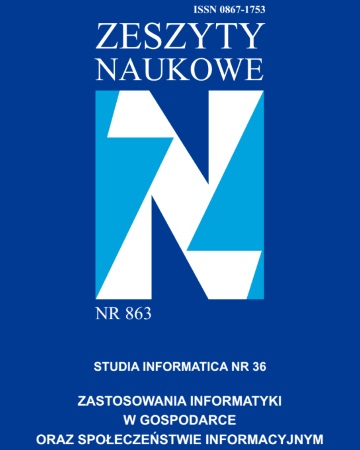
ISSN: 0867-1753
eISSN: 2300-410X
OAI
DOI: 10.18276/si.2015.36-11


Issue archive /
ZN 863 SI nr 36
Analiza zbioru wiadomości e-mail z zastosowaniem sieci społecznych
(An analysis of the set of e-mails with social networks)
| Authors: |
Urszula
Boryczka
Uniwersytet Śląski w Katowicach Jan Kozak Uniwersytet Śląski w Katowicach Barbara Probierz Uniwersytet Śląski w Katowicach |
| Keywords: | Enron E-mail Social Network Analysis data analysis |
| Data publikacji całości: | 2015 |
| Page range: | 12 (153-164) |
Abstract
In this article is proposed an approach based on the Social Network Analysis and its practical applicability in the study of the organization in terms of flow processes e-mails employees. The aim of this paper is to analyze the interaction between individual employees corporation used to designate staff-leaders from the point of view of spreading information or to influence those in the immediate vicinity. This analysis further work should contribute to the creation of the algorithm, the application of which will be used to improve the accuracy of the classification of e-mail messages to specific folders in the mailboxes of employees. The proposed method has been tested on a public dataset Enron Email.
Download file
Article file
Bibliography
| 1. | Aral S., Van Alstyne M. (2007), Network structure & information advantage. |
| 2. | Bekkerman R., McCallum A., Huang G. (2004), Automatic categorization of email into folders: Benchmark experiments on Enron and SRI corpora, Center for Intelligent Information Retrieval, Technical Report IR. |
| 3. | Boryczka U., Probierz B., Kozak J. (2014), An Ant Colony Optimization Algorithm for an Automatic Categorization of Emails, Computational Collective Intelligence. Technologies and Applications, LNCS, Springer, Berlin, s. 583–592. |
| 4. | CALO (2014), A Cognitive Assistant that Learns and Organizes, www.ai.sri.com/project/ CALO (2.11.2014). |
| 5. | Cummings J.N., Cross R. (2003), Structural properties of work groups and their consequences for performance, „Social Networks”, no. 25, s. 197–210. |
| 6. | Gloor P.A. (2006), Swarm Creativity: Competitive Advantage through Collaborative Innovation Networks, Oxford Univrsity Press. |
| 7. | Gloor P., Grippa F., Putzke J., Lassenius C., Fuehres H., Fischbach K., Schoder D. (2012), Measuring social capital in creative teams through sociometric sensors, „International Journal of Organisational Design and Engineering”. |
| 8. | Moreno J.L. (1953), Who Shall Survive? Foundations of Sociometry, Group Psychotherapy and Sociodrama, Beacon House, Beacon, Nowy Jork. |
| 9. | Stępka P., Subda K. (2004), Wykorzystanie analizy sieci społeznych (SNA) do budowy organizacji opartej na wiedzy, „E-mentor”, nr 1 (28). |
| 10. | Wilson G.C., Banzhaf W. (2009), Discovery of email communication networks from the enron corpus with a genetic algorithm using social network analysis. |